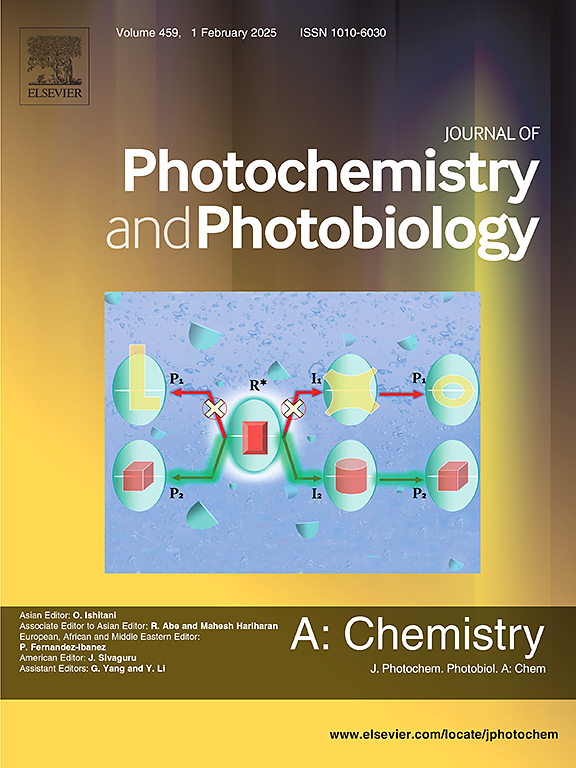利用mof中封装的多金属氧酸盐进行声光催化Cr(VI)还原:揭示环保铬修复的途径
IF 4.7
3区 化学
Q2 CHEMISTRY, PHYSICAL
Journal of Photochemistry and Photobiology A-chemistry
Pub Date : 2025-05-18
DOI:10.1016/j.jphotochem.2025.116506
引用次数: 0
摘要
本文采用水热法制备了Keggin多金属氧酸盐包封的铝基卟啉金属有机骨架(POM @ T4CP-MOF)。通过傅里叶变换红外、紫外可见、粉末x射线衍射、扫描电子和能量色散光谱、热重和差示扫描量热分析、荧光、x射线光电子发射光谱和zeta电位对POM @ T4CP-MOF进行了全面的表征,以评估结构相互作用、织构性能和形貌。卟啉与Al-O单元的强配位以及Keggin POM在MOF孔隙中的插入使得POM @ T4CP-MOF表现出广泛的可见光捕获能力、即时的光生电荷响应和良好的化学稳定性。在由Cr(VI)组成的水溶液中,POM @ T4CP-MOF表现出独特的声光催化和光催化活性。POM @ t4cp - mof的声光催化和光催化反应速率分别为0.48 mg/L min和0.15 mg/L min,是光催化的3.2倍。声光催化技术与基于卟啉的MOFs相结合,可以证明是一种成功的策略,可以增强基于MOFs的光催化系统,用于Cr(VI)等有害化学物质的还原过程。本文章由计算机程序翻译,如有差异,请以英文原文为准。

Harnessing encapsulated polyoxometalate in MOFs for sonophotocatalytic Cr(VI) reduction: Unveiling the pathway to eco-friendly chromium remediation
In this study aluminium-based porphyrin metal–organic framework encapsulated with Keggin polyoxometalate namely (POM @ T4CP–MOF) has been synthesized by hydrothermal process. The POM @ T4CP–MOF is thoroughly characterized to evaluate structural interaction, textural properties and morphology by fourier transform infrared, ultraviolet–visible, powder X-ray diffraction, scanning electron and energy dispersive spectroscopy, thermogravimetric and differential scanning calorimetric analysis, fluorescence, X-rays photoelectron emission spectroscopy and zeta potential. The presence of porphyrin with strong coordination of Al–O units and insertion of Keggin POM in the pores of MOF allowed the POM @ T4CP–MOF to demonstrate a wide range of visible light harvesting capacity, immediate photogenerated charge response and good chemical stability. In an aqueous solution composed of Cr(VI), POM @ T4CP–MOF demonstrated unique sonophotocatalytic and photocatalytic activities. The rate of reaction in sonophotocatalysis and photocatalysis for the POM @ T4CP–MOFs is found to be 0.48 mg/L min and 0.15 mg/L min respectively, which is 3.2 times higher than photocatalysis. Sonophotocatalytic technology in conjunction with porphyrin-based MOFs could prove to be a successful tactic in enhancing MOFs-based photocatalytic systems to be utilized in the reduction process of harmful chemicals like Cr(VI).
求助全文
通过发布文献求助,成功后即可免费获取论文全文。
去求助
来源期刊
CiteScore
7.90
自引率
7.00%
发文量
580
审稿时长
48 days
期刊介绍:
JPPA publishes the results of fundamental studies on all aspects of chemical phenomena induced by interactions between light and molecules/matter of all kinds.
All systems capable of being described at the molecular or integrated multimolecular level are appropriate for the journal. This includes all molecular chemical species as well as biomolecular, supramolecular, polymer and other macromolecular systems, as well as solid state photochemistry. In addition, the journal publishes studies of semiconductor and other photoactive organic and inorganic materials, photocatalysis (organic, inorganic, supramolecular and superconductor).
The scope includes condensed and gas phase photochemistry, as well as synchrotron radiation chemistry. A broad range of processes and techniques in photochemistry are covered such as light induced energy, electron and proton transfer; nonlinear photochemical behavior; mechanistic investigation of photochemical reactions and identification of the products of photochemical reactions; quantum yield determinations and measurements of rate constants for primary and secondary photochemical processes; steady-state and time-resolved emission, ultrafast spectroscopic methods, single molecule spectroscopy, time resolved X-ray diffraction, luminescence microscopy, and scattering spectroscopy applied to photochemistry. Papers in emerging and applied areas such as luminescent sensors, electroluminescence, solar energy conversion, atmospheric photochemistry, environmental remediation, and related photocatalytic chemistry are also welcome.

 求助内容:
求助内容: 应助结果提醒方式:
应助结果提醒方式:


